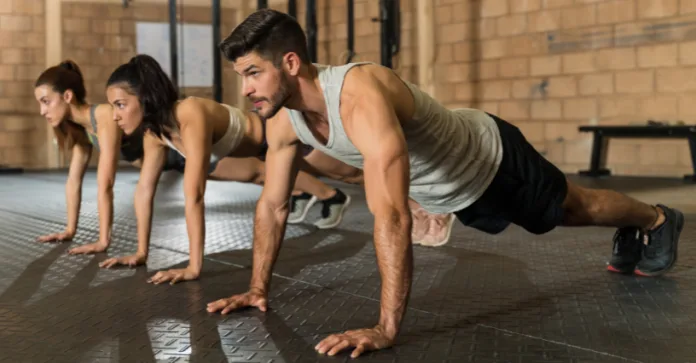From women’s push-ups to diamond push-ups and one-arm push-ups – there are so many variations of push-ups that there’s a successful option for everyone, regardless of training level.
Find out which types of push-ups for beginners and advanced students are worth including in your training plan to improve your skills, engage and strengthen more muscles, or break up your routine with exercises for chest, triceps and shoulders .
Push-ups for beginners
If you are a beginner in strength training, opt for the simplest versions of push-ups, which offer a lot of stability during their execution. This will make it easier for you to adapt the difficulty range to your fitness level, develop the right technique and get the right results in the form of sculpted and stronger muscles.
Wall push-ups
Wall push-ups are the best way to incorporate this type of exercise into your workout plan and strengthen your entire upper body—the pectoralis major and minor muscles, triceps, and shoulder blade. In addition, the core muscles, glutes, quadriceps (thigh muscles) and calves are involved in maintaining the plank position.
Application: Stand 1-1.5 steps away from a wall. Place both your hands on the wall so that they are slightly wider than your shoulders, but at shoulder height, and your wrists form a single line with your shoulders.
Keep your body in a high plank position (feet hip-width apart or together, hips in line with shoulders, abs, glutes and thighs properly stretched).
Try to bend your elbows and lower your body towards the wall. When your forehead is close to the wall, proceed to straighten your arms and return to the starting position.
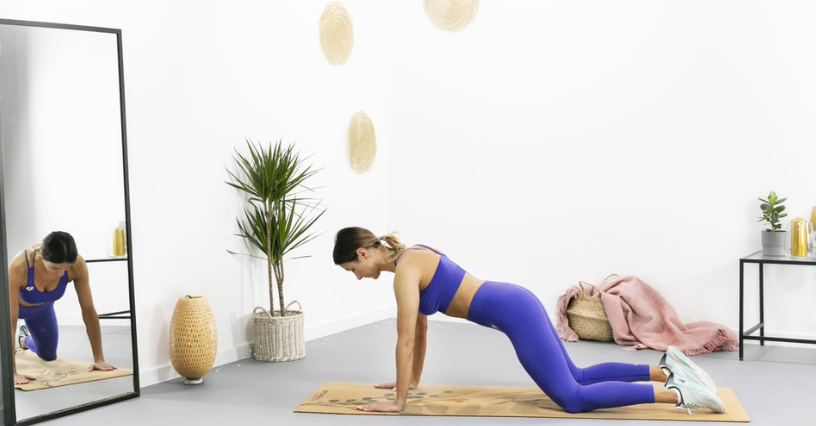
Push-ups for women
In other words, knee push-ups are also a great way to learn classic push-ups and strengthen your chest, shoulders, and abs. An additional benefit of regularly performing push-ups for women, in the case of ladies, is to strengthen the breasts and reduce the so-called bat arms, or sagging skin of the arms .
Application: Kneel down to a knee support position. Place your hands slightly wider than your shoulders, lift your legs up and cross your legs at the level of the calves (you can leave them on the floor). Keep your head in line with your spine, your abs and buttocks tight, and your back straight. Begin to bend your arms and lower your torso as low as possible (without touching the floor). Straightening your arms at the elbows, return to the starting position. Avoid bending the hip and neck at all times.
Classic push-ups
The basic version of push-ups works the whole body at once – from arms to chest to abs and lower body. Plus, it allows you to build better balance and stability.
Application : Get your body into a high plank position. Keep your back straight, your head as an extension of your spine. Place your feet close together or hip-width apart. Slowly lower your entire body toward the floor (careful: the hips must not touch the floor first and the back must bend in the lumbar region) until you are very nearly above it. Then exhale and push yourself back up to the starting position.
Advanced types of push-ups
Have you mastered the technique of classic push-ups? Try more challenging variations of this popular exercise and adapt them to your training routine and the goals you want to achieve.
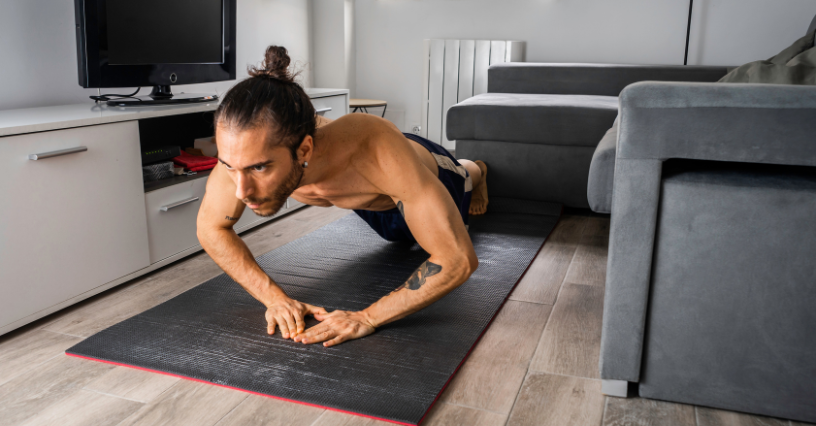
Diamond push-ups
Also known as narrow push-ups, this is one of the more difficult versions of push-ups, where the thumbs and index fingers come together to form a diamond and the triceps (triceps) muscles are worked the most.
They are perfect if you want to sculpt your chest and triceps and get wider shoulders. In addition, diamond push-ups will help you correct your posture and ensure better body balance .
Application : Take the same position as in a classic push-up, except that the hands are joined by the thumbs and forefingers and positioned under the chest. Keep your elbows close to your body. After lowering your body to the floor, hold the position for 1 second before returning to the starting position .
Resistance push-ups on the back
This is a great triceps exercise, but it also allows you to work your lower chest and front shoulder muscles. You will need an elevated surface to perform them (chair, aerobic stepper set to level 2 or 3, box, upright bench, etc.) .
Application : Stand with your back to a step and sit on it. Place your hands below your shoulders or slightly wider, pointing your fingers in front of you. Keep your back straight, chest open and abs tight.
The legs are placed completely on the floor, below the knees (the easier variant) or the legs are straight and resting on the heels (the more difficult variant). Alternatively, choose an additional weight (such as a puck) and place it at the lower abdominal level (the most difficult variation).
You slowly begin to bend your arms at the elbows (point them behind you) and lower your buttocks to the floor (without touching the ground). Straighten your arms, lift your torso and return to the starting position .
Swedish push-ups
Dips or handrail push-ups are another exercise that targets strong triceps and anterior shoulder muscles .
Application : Grasp the handrails using a neutral grip, i.e. with four fingers pointing outwards. Bend your legs so they don’t touch the ground. Keep your arms straight at the elbows and close to your torso. You begin to lower your torso by bending your arms at the elbows (toward the back) until you feel tension in your shoulders. Return to the starting position .
Spiderman push-ups
By far one of the most difficult push-up variations, which mainly engages: the triceps, the pectoralis major, the shoulder muscles, as well as the rectus abdominis and obliques .
Application : Take the starting position as in a traditional push-up. Lowering your body, you begin to pull your right leg bent from the knee to the elbow (as close as possible). Return to the starting position and repeat with the left leg .
Push-ups on one hand
Another type of push-ups dedicated to experienced followers of bodyweight training .
Application : Take the starting position as in a classic push-up, but put one arm behind you – rest it on the sacrum of the spine, for example. Perform the same movement as a normal push-up .
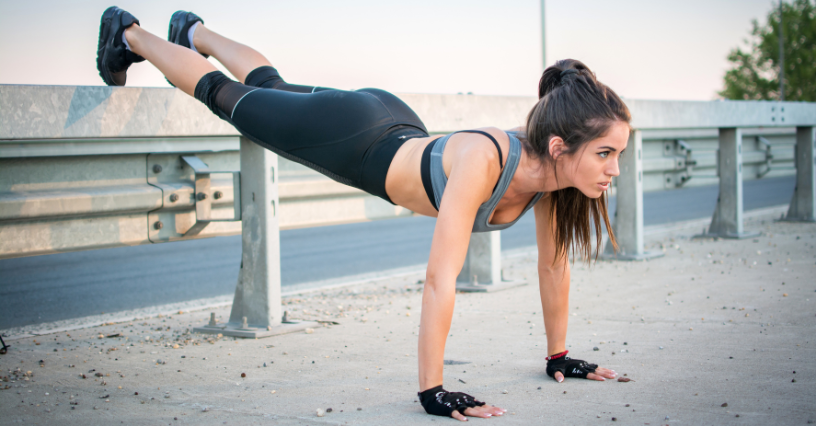
Push-ups with raised legs
You should add this type of push-up to your training plan if you want to strengthen and develop your chest and shoulder muscles. In addition, the triceps, gluteal muscles and abdominal muscles work here .
Application : Place your feet on a stable surface (box, chair, stool, etc.) at a height so that your body is parallel to the ground. Rest of body positioned as for a traditional push-up. Perform the movement as in the classic version .
Push-ups in hands
A popular variation of the push-up among CrossFit enthusiasts, to perform it you need the ability to stand on your hands and a wall, ladders or the help of a partner.
Application: Stand facing about 1-1.5 steps from the wall and lower yourself into a front lunge. Jump your feet off the floor to take the position in your hands (prop your feet up against the wall/ladder or ask your partner to hold them). Begin to lower your body vertically toward the floor until your elbows are bent at about 90 degrees. With an exhalation, slowly straighten your arms at the level of the elbows and return to the starting position.
Push-ups on handles – if and when is it worth using handles?
Using push-up handles gives you a wide range of maneuvers to add variety to your workout, for example: choosing the intensity of the exercises, setting the angle of the body to engage certain muscle parts by performing the movement at the right depth, etc. It’s a good way to develop strong triceps and sculpt your abs, as well as relieve stress on your wrists.
Depending on your needs, you can perform shoulder- width /wider-than-shoulder/narrower-than-shoulder/hip-line push-ups, handstand push-ups or the so-called L-sit (from a straight seated position, raise body on L-shaped handles).
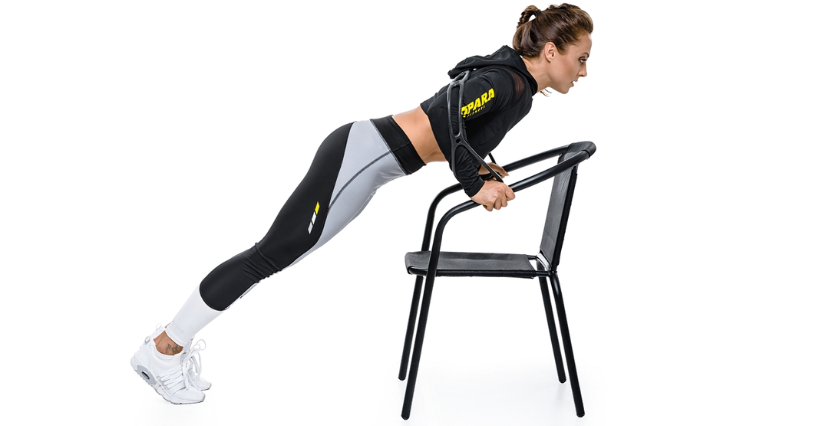
Push-ups with elastic bands and other training equipment
When looking for variety in your workout, try push-ups with additional equipment such as resistance bands, bosu or TRX bands. Why? By choosing an unstable surface, for example, you engage more strongly the core muscles responsible for stabilizing the spine and correct posture. External resistance, on the other hand, makes it harder and requires more force to perform the exercise.
- band push-ups – In the forward lunge, extend the hands slightly more than the shoulders. Place the elastic on your back, at shoulder height, and hold the ends in your hands. Perform the movement as in a traditional push-up;
- push-ups – place the body balance platform soft side down. Grab the edges of the hard part of the bosu and position yourself as in a classic push-up;
- push-ups on the TRX – the easier version with hands on the handles: put the TRX in position 2, grab the handles and go into a forward push-up (abdominals tight, body in one line, arms perpendicular to the axis of the body at shoulder height, feet supported on the floor). Perform the movement just like a traditional push-up. More difficult version with legs in TRX (the so-called atomic push up): Position yourself in the same way as a traditional push-up, except that you put your feet in the lower straps of the TRX handles. Do a downward movement keeping your abs and glutes tight (avoid deepening the lordosis in your lumbar spine), then return to the starting position and pull your knees to your chest.
How often to do push-ups?
The main advantage of push-ups is that they can be performed practically anywhere, without the need for any equipment.
Thanks to the large number of variations with different degrees of difficulty and complexity of the movements, you can engage almost your entire body or you can focus on sculpting and strengthening specific parts of the muscles.
Depending on your needs and training plan, push-ups can be successfully performed even on a daily basis. They can be incorporated into:
warm-up, the so-called split (training a large muscle part and 1-2 smaller ones, for example chest – triceps or chest – biceps), circuit training, functional training, FBW (Full Body Workout), tabata or intervals.
Regardless of the variation of push-ups you do, try to maintain total control of the movements and adapt the interval and intensity of the exercise to your level of fitness. Focus on breathing: inhale as you lower your torso, exhale as you push your body up.


